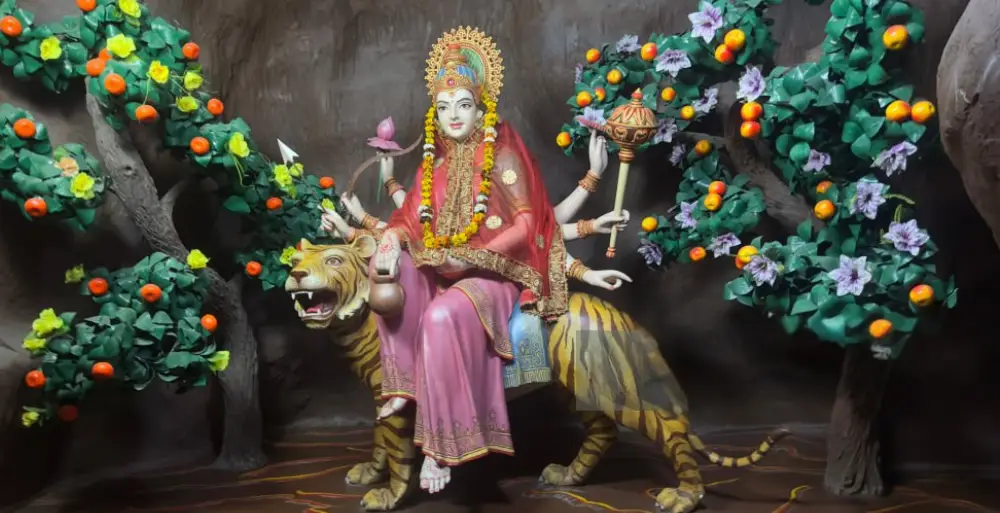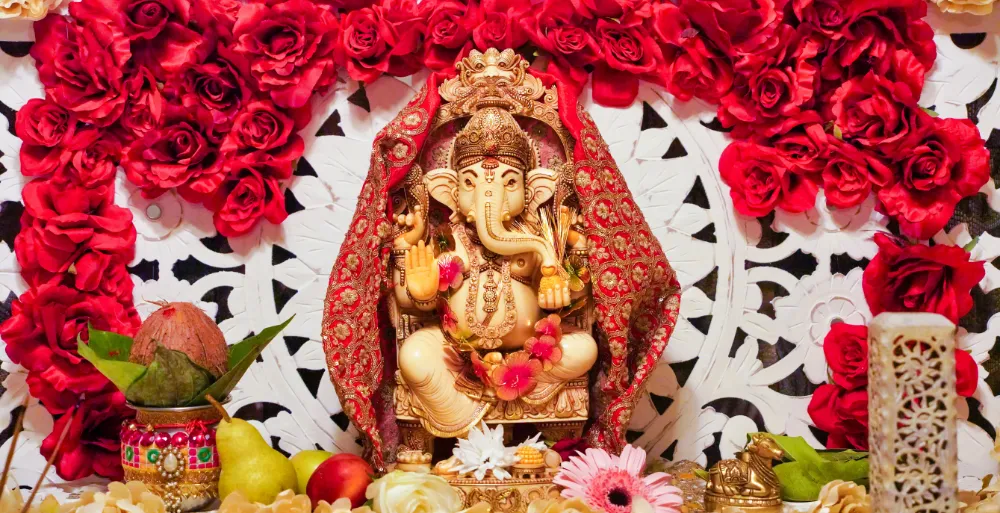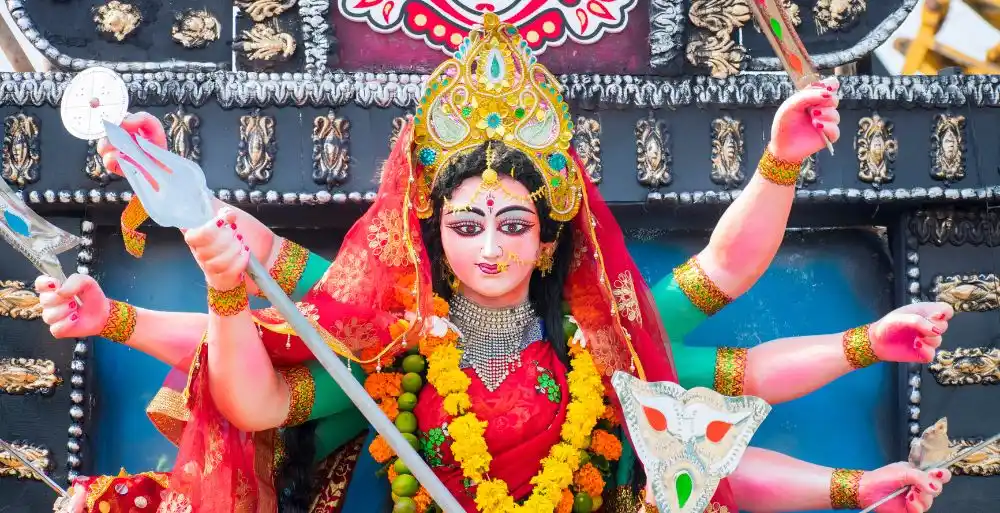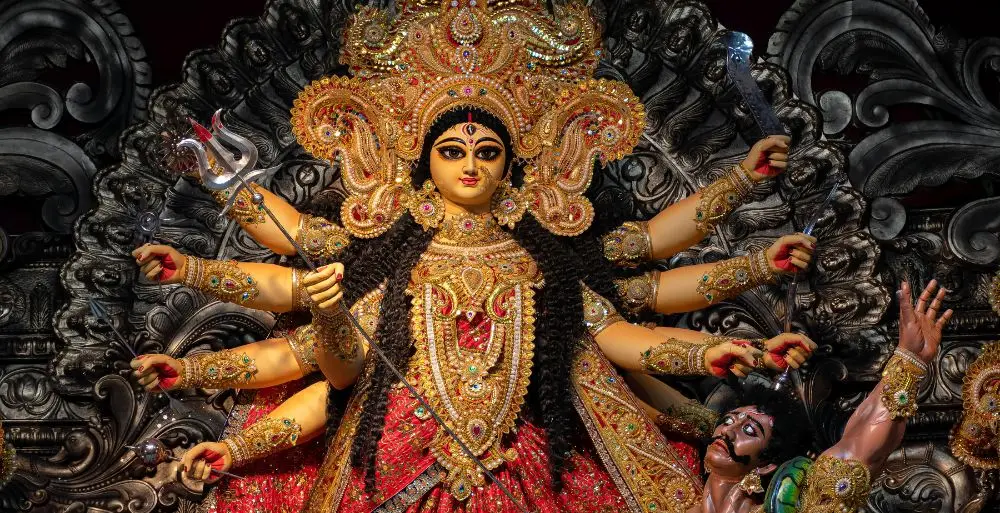People across India celebrate the nine-day festival of Navratri, creating a spiritually uplifting and vibrant atmosphere. Each day of the festival holds great religious significance. On the 4th day of Navratri, we pay tribute to the Goddess Kushmanda, a manifestation of Durga known for her creative abilities and the capacity to illuminate the universe. Devotion, color, and festivity fill this day as worshippers come together to honor the goddess
This article delves into the deep meaning of the 4th day of Navratri, its celebration, and the associated rituals. Whether you are observing it for the first time or have been a part of the celebration for years, this guide will enhance your understanding of this sacred day.

Who is Goddess Kushmanda?

On the 4th day of Navratri, devotees worship Goddess Kushmanda. In Hindu mythology, Kushmanda is said to have created the universe with her divine smile. The term “Kushmanda” comes from three Sanskrit words: “Ku” (meaning little), “Ushma” (meaning warmth), and “Anda” (meaning cosmic egg). Together, her name signifies “the creator of the cosmic egg,” referring to her role in creating the universe and filling it with life and energy.
Worshipping Goddess Kushmanda is believed to bring health, wealth, and prosperity. She is portrayed as having eight hands and is often referred to as Ashtabhuja Devi. Her hands carry different symbolic items, including a kamandalu, bow, arrow, lotus, pot of nectar, discus, mace, and Kampala (rosary). This image of the goddess represents her power to end darkness and spread light in all directions.

Significance of the 4th Day of Navratri
The 4th day of Navratri is significant as it follows the worship of Goddess Brahmacharini. On this day, devotees turn to Kushmanda, who is believed to have created the cosmos. Her divine power symbolizes nourishment and nurturing, bringing light and warmth to the world.
Devotees seek blessings for good health, growth, and longevity, believing that worshipping Goddess Kushmanda can remove suffering and illnesses, and fill their homes with positive energy.
Also Read: 1st Day of Navratri: Goddess Shailputri Worship Guide

Rituals and Customs on the 4th Day of Navratri

The 4th day of Navratri is a day of dedication and devotion, marked by various rituals and customs. Here’s an overview of how this auspicious day is celebrated:
- Early Morning Rituals: Devotees wake up early to perform morning rituals, including bathing, wearing fresh clothes, and offering special prasad (sacred food) to the goddess. Many people wear orange, the colour associated with Goddess Kushmanda, symbolizing brightness and creativity.
- Pooja Sthal Setup: The altar, or puja sthal, features a beautiful arrangement of flowers, incense sticks, and lamps. In the center, a statue or picture of Goddess Kushmanda is displayed, and worshippers offer fruits, sweets, flowers, and fresh water.
- Chanting Mantras: Devotees chant mantras to invoke the blessings of Goddess Kushmanda. One powerful mantra for this day is: “Om Devi Kushmandayai Namah”.
- Fasting: Many devotees continue their fast on the fourth day, some opting for a fruit-based fast while others consume only light vegetarian food. Fasting is a way to purify the body and mind, enhancing spiritual focus and devotion.
Kanya Puja: While this ritual is often done on the eighth or ninth day, some devotees also perform it on the fourth day. Kanya Puja involves worshipping young girls as incarnations of the goddess, manifesting divine femininity and seeking their blessings.

The symbolism of the Orange Color on the 4th Day
Each day of Navratri has a specific color, with orange representing the 4th day. This vibrant hue signifies creativity, energy, and enthusiasm, aligning with Goddess Kushmanda’s role as the bringer of light and warmth.
Devotees often wear orange dresses to represent the goddess’s radiant energy, and it also inspires a sense of joy and positivity throughout the day’s celebrations
Also Read: 2nd Day of Navratri: Worship Guide for Maa Brahmacharini

The Spiritual Aspect of Day 4: Awakening the Anahata Chakra
Spiritually, the 4th day of Navratri corresponds to the Anahata Chakra (Heart Chakra). This energy centre is located in the chest and governs feelings of love, compassion, and empathy.
Worshipping Goddess Kushmanda helps in activating the Anahata Chakra, allowing devotees to experience a deeper connection to themselves, others, and the divine.
By focusing on this chakra, devotees open their hearts to positive energy and emotional healing. This day is not only a time for outward celebration but also for inner spiritual awakening.

How to Perform the Navratri Puja at Home on the 4th Day of Navratri

For those looking to perform a simple yet powerful Navratri Puja at home, follow these steps:
- Cleanse the Space: Thoroughly clean your home and puja space. Set up the altar with flowers, an image of Goddess Kushmanda, incense sticks, and lamps.
- Begin with a Prayer: Start by invoking Lord Ganesha, asking him to remove any obstacles from your prayers.
- Chant the Mantras: Chant the Kushmanda mantra: “Om Devi Kushmandayai Namah” while offering flowers and sweets to the deity.
- Offer Prasad: Prepare a simple prasad, such as fruits or sweets, and place it in front of the goddess.
- Perform Aarti: End the puja by singing the Durga Aarti and circling the lamp around the deity’s image.
Distribute Prasad: After the puja, share the prasad with family and friends as a symbol of divine blessings.
Also Read: 3rd day of Navratri: Goddess Chandraghanta Worship Guide

Conclusion For 4th Day of Navratri:
The 4th day of Navratri holds immense spiritual significance as devotees honour Goddess Kushmanda, the creator of the universe. Through prayers, fasting, and rituals, worshippers seek her blessings for health, prosperity, and spiritual enlightenment.
Symbolized by the vibrant colour orange, this day brings light, joy, and creativity into the lives of all who celebrate it. Whether performing traditional rituals or reflecting on the day’s spiritual significance, the 4th day of Navratri offers a profound opportunity for personal growth and divine connection.





